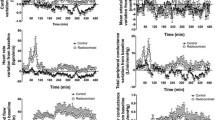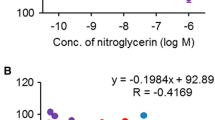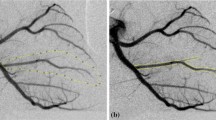Summary
To study the effects of a contrast agent commonly used in coronary angiography (Renografin) on myocardial flow distribution, the main left coronary arteries of 9 dogs were cannulated and perfused from the carotid arteries. The left anterior descending coronary artery (LAD) was ligated and cannulated to monitor peripheral coronary pressure (PCP). Myocardial blood flow and distribution were determined with radioactive microspheres before Renografin administration and after resolution of the brief period of hypotension following injection of 2–3.5 cm3 of the contrast agent directly into the coronary perfusion tubing. Renografin significantly increased blood flow to normal myocardial regions (0.90 to 1.51 cm3·g−1·min−1, p<0.001). Despite this flow augmentation and normal aortic and coronary perfusion pressures, PCP decreased from 28.0±3.4 to 24.4±2.8 mm Hg (p<0.001), and myocardial blood flow toe central ischemic LAD area halved from 0.17±0.04 to 0.09±0.03 cm3·g−1·min−1 (p<0.025). The inner/outer left ventricular wall blood flow ratio in the central ischemic region increased from 0.28 to 0.39 (p<0.05). Thus the contrast agent causes a coronary steal or redistribution of coronary flow away from already ischemic regions, and the endocardium appears to be less affected than the epicardium.
Similar content being viewed by others
References
Bassan, M., W. Ganz, H. S. Marcus, H. J. C. Swan: The effect of intracoronary injection of contrast medium upon coronary blood flow. Circulation51, 442–445 (1975).
Becker, L. C.: Conditions for vasodilator-induced coronary steal in experimental myocardial ischemia. Circulation57, 1103–1110 (1978).
Bourassa, M. G., J. Noble: Complication rate of coronary arteriography: a review of 5250 cases studied by a percutaneous femoral technique. Circulation53, 106–114 (1976).
Brown, B. G., W. D. Gundel, V. L. Gott, J. W. Covell: Coronary collateral flow following acute coronary occlusion: a diastolic phenomenon. Cardiovasc. Res.8, 621–631 (1974).
Cohen, M. V.: Quantitation of collateral and ischemic flows with microppheres and diffusible indicator. Amer. J. Physiol.234, H487-H495 (1978).
Cohen, M. V.: Coronary steal in awake dogs: a real phenomenon. Cardiovasc. Res. 16, 339–349 (1982).
Cohen, M. V., E. H. Sonnenblick, E. S. Kirk: Coronary steal: its role in detrimental effect of isoproterenol after acute coronary occlusion in dogs. Amer. J. Cardiol.38, 880–888 (1976).
Gould, K. L., K. Lipscomb: Effects of coronary stenoses on coronary flow reserve and resistance. Amer. J. Cardiol.34, 48–55 (1974).
Higgins, C. B., W. Schmidt: Alterations in calcium levels of coronary sinus blood during coronary arteriography in the dog. Circulation58, 512–519 (1978).
La Croix, P., P. Linee, J. B. Le Polles: Effects of some coronary vasodilator drugs on collateral hemodynamics after chronic myocardial ischemia in the anesthetized dog: appropriate or inappropriate redistribution? J. Pharmacol. Exp. Ther.204, 645–654 (1978).
Popio, K. A., A. M. Ross, J. M. Oravec, J. T. Ingram: Identification and description of separate mechanisms for two components of Renografin cardiotoxicity. Circulation58, 520–528 (1978).
Rembert, J. C., L. M. Boyd, W. P. Watkinson, J. C. Greenfield, Jr.: Effect of adenosine on transmural myocardial blood flow distribution in the awake dog. Amer. J. Physiol.239, H7-H13 (1980).
Snedecor, G. W., W. G. Cochran:Statistical Methods. pp. 91–98. 6th ed. Iowa State University Press (Ames, Iowa, 1967).
Author information
Authors and Affiliations
Additional information
Dr. Cohen is the recipient of a Research Career Development Award from the National Heart, Lung and Blood Institute, HL-00281.
This study was supported in part by National Heart, Lung and Blood Institute Grant HL-17809.
Rights and permissions
About this article
Cite this article
Cohen, M.V. The effects of intracoronary Renografin injection on coronary flow and distribution in dogs following coronary occlusion. Basic Res Cardiol 78, 364–372 (1983). https://doi.org/10.1007/BF02070161
Received:
Issue Date:
DOI: https://doi.org/10.1007/BF02070161




